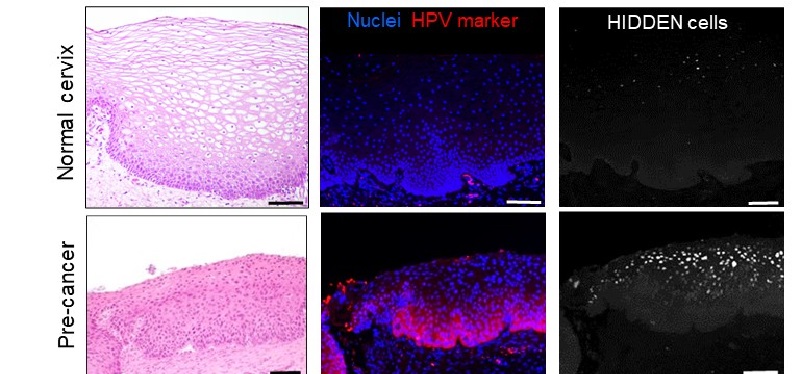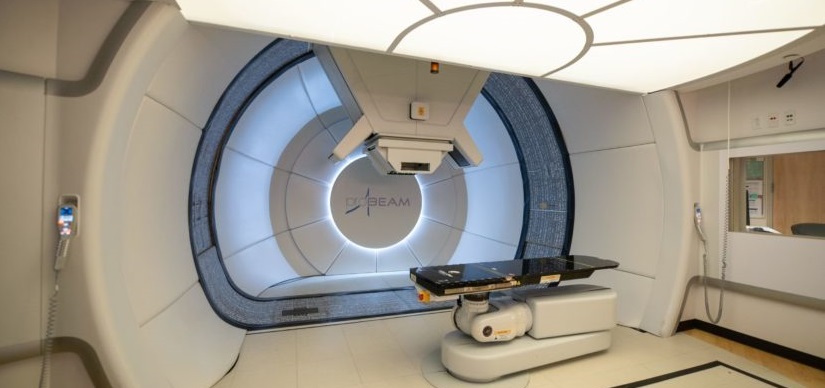Analysis of HPV-Positive Cells Reveals New Population Found in Cancer
Research By: Susanne Wells, PhD
Post Date: April 11, 2023 | Publish Date: April 8, 2023

Experts at Cincinnati Children’s using single-cell sequencing technology discovered a HIDDEN compartment of cells in HPV-infected tissues present in several types of cancer
Persistent infection with human papillomavirus (HPV) leads to 5% of all cancers worldwide, including cervical cancers in women and an increasing rate of oropharyngeal cancers in men.
Although routine screenings (e.g. pap smears) test for active HPV infection as a risk factor for cervical cancer, latent infection is often undetectable. Once an individual is infected, no cure exists to eliminate the virus.
The specifics of how HPV reprograms the host epithelium is not well understood, which has prevented scientists from developing effective antivirals. Now, a research team at Cincinnati Children’s and the University of Cincinnati, led by Susanne Wells, PhD, reports a significant breakthrough in the understanding of the origins of cancer and the role HPV infections play in its progression.
Details were published April 8, 2023, in Nature Communications.
Mary Bedard, PhD, Tafadzwa Chihanga, PhD, and colleagues compared HPV16-infected organoids to uninfected epithelial organoids using single-cell RNA sequencing analysis to define the gene signature of the distinct cell subpopulations that form the layers of stratified epithelial tissue. In doing so, the team was able to determine how HPV reprograms these subpopulations and discovered that HPV infection drives formation of a previously undescribed compartment that may support the HPV life cycle and promote cancer development.
Discovering a HIDDEN cell compartment
The team found that this top compartment is composed of HPV-induced differentiation dissonant epithelial nonconventional (HIDDEN) cells. These cells were further detected in patient-derived cervical and tonsillar organoids, in patient biopsies of HPV+ cervical pre-cancers, and in HPV+ head and neck cancers.
Further analysis demonstrated that a transcription factor (ELF3) is upregulated by HPV and is a crucial component for the conservation of the HIDDEN compartment, thus making ELF3 a potential therapeutic target. Inhibition of HPV reprogramming of infected tissues, e.g. HIDDEN cells, represents a potential approach for development of antivirals that clear HPV infection and/or medicines that prevent disease progression to cancer.
Taken together, the team was able to use organoids to define a new cell subpopulation (HIDDEN cells) that probably promotes disease, to translate this finding to patient biopsies harboring stages of HPV-driven cancer, and to identify novel therapeutic approaches for combating HPV infection and disease.
“This is the first step to understand the complex factory that supports a latent HPV system,” Wells says.
Next steps
This study suggests that many more doors to other compartments are yet to be opened.
“We want to understand every room,” Wells says. “But we picked one that is morphologically indistinguishable from normal healthy tissue but by cell population more similar to cancerous tissue.”
This study not only showcases the many benefits of organoid technologies in development at Cincinnati Children’s but also uncovers potential biomarkers of HPV latency and novel therapeutic targets that may be applied to inhibit viral infection and several types of HPV-driven cancers.
“This HIDDEN compartment is in itself a great biomarker. We can swab and isolate cells and use the marker to identify cells as HPV infected,” Wells says. “This is important because we don’t know who is latently infected. If we did, we could focus in more depth on those patients most at risk of developing HPV-driven cancers.”
Longer term, the team hopes to further understand the effects of the HIDDEN cells and how they interact with the other populations of the tissue and the specific roles of ELF3 in the formation of a tumorigenic environment. Finally, this method of identifying high-risk factors in cancer may also prove useful for studying other tissues to further recognize potential candidates for gene targeting and develop preventative clinical approaches.
| Original title: | Single cell transcriptomic analysis of HPV16-infected epithelium identifies a keratinocyte subpopulation implicated in cancer |
| Published in: | Nature Communications |
| Publish date: | April 8, 2023 |
Research By

The goal of our studies is to advance our understanding of both HPV-related and -unrelated squamous cell carcinoma (SCC) development, and to develop new approaches to the diagnosis and treatment of HPV as a major cause of cancer worldwide.






